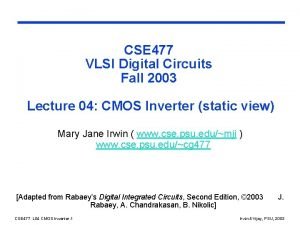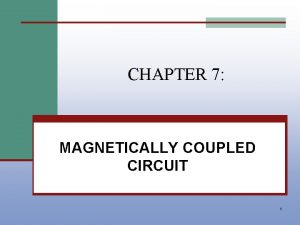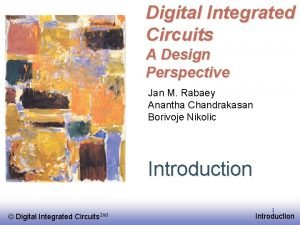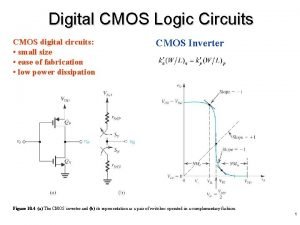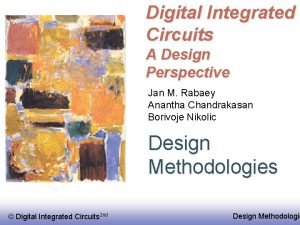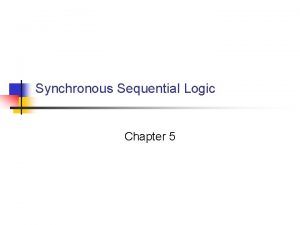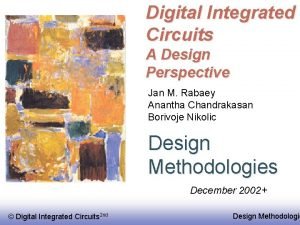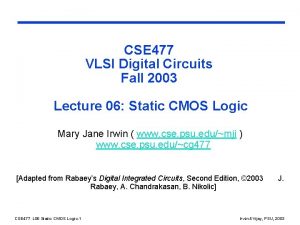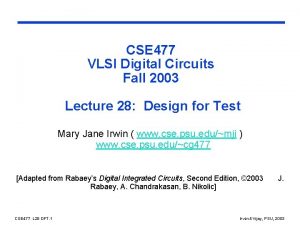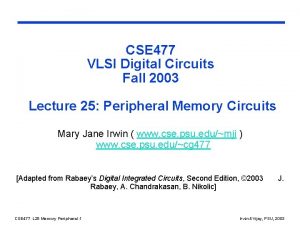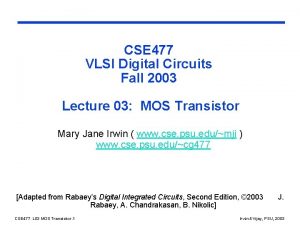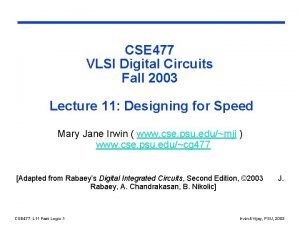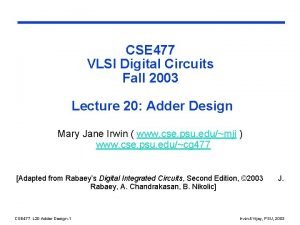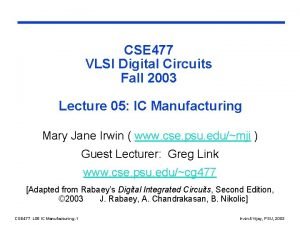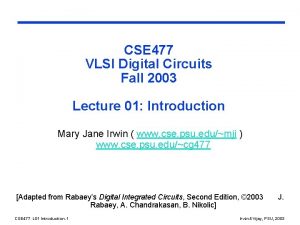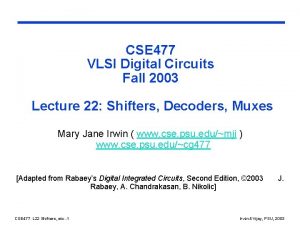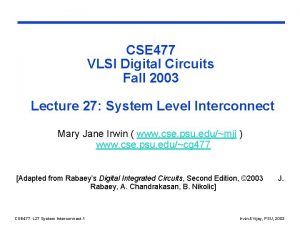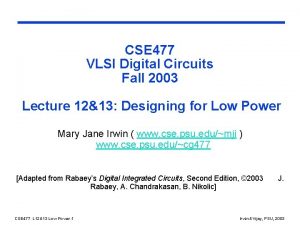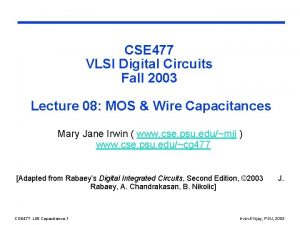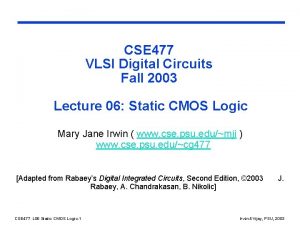CSE 477 VLSI Digital Circuits Fall 2003 Lecture















- Slides: 15

CSE 477 VLSI Digital Circuits Fall 2003 Lecture 21: Multiplier Design Mary Jane Irwin ( www. cse. psu. edu/~mji ) www. cse. psu. edu/~cg 477 [Adapted from Rabaey’s Digital Integrated Circuits, Second Edition, © 2003 Rabaey, A. Chandrakasan, B. Nikolic] CSE 477 L 21 Multiplier Design. 1 J. Irwin&Vijay, PSU, 2003

Review: Basic Building Blocks q Datapath l Execution units - Adder, multiplier, divider, shifter, etc. q l Register file and pipeline registers l Multiplexers, decoders Control l q Interconnect l q Finite state machines (PLA, ROM, random logic) Switches, arbiters, buses Memory l Caches (SRAMs), TLBs, DRAMs, buffers CSE 477 L 21 Multiplier Design. 2 Irwin&Vijay, PSU, 2003

Review: Adder Comparisons MCC RCA best area* power*speed (N) CSE 477 L 21 Multiplier Design. 3 CSkip best area*speed ( N) KS PPA best speed (log. N) Irwin&Vijay, PSU, 2003

Multiply Operation q Multiplication is just a a lot of additions N multiplicand multiplier partial product array N can be formed in parallel double precision product 2 N CSE 477 L 21 Multiplier Design. 4 Irwin&Vijay, PSU, 2003

Multiplication Approaches q Right shift and add l Partial product array rows are accumulated from top to bottom on an N-bit adder - After each addition, right shift (by one bit) the accumulated partial product to align it with the next row to add l q Time for N bits Tserial_mult = O(N Tadder) = O(N 2) for a RCA Making it faster l Use a faster adder l Use higher radix (e. g. , base 4) multiplication – O(N/2 Tadder) - Use multiplier recoding to simplify multiple formation l q Form the partial product array in parallel and add it in parallel Making it smaller (i. e. , slower) l Use an array multiplier - Very regular structure with only short wires to nearest neighbor cells. Thus, very simple and efficient layout in VLSI - Can be easily and efficiently pipelined CSE 477 L 21 Multiplier Design. 5 Irwin&Vijay, PSU, 2003

Making it Faster: Tree Multiplier Structure 0 D Q (‘ier) 0 D 0 D (‘icand) partial product array reduction tree fast carry propagate adder (CPA) CSE 477 L 21 Multiplier Design. 6 mux + reduction tree (log N) + CPA (log N) interconnect multiple forming circuits P (product) Irwin&Vijay, PSU, 2003

(4, 2) Counter q Built out of two (3, 2) counters (just FA’s!) l l all of the inputs (4 external plus one internal) have the same weight (i. e. , are in the same bit position) the internal carry output is fed to the next higher weight position (indicated by the ) (3, 2) CSE 477 L 21 Multiplier Design. 7 Note: Two carry outs - one “internal” and one “external” Irwin&Vijay, PSU, 2003

Tiling (4, 2) Counters q (3, 2) (3, 2) Reduces columns four high to columns only two high l l Tiles with neighboring (4, 2) counters Internal carry in at same “level” (i. e. , bit position weight) as the internal carry out CSE 477 L 21 Multiplier Design. 9 Irwin&Vijay, PSU, 2003

4 x 4 Partial Product Array Reduction q Fast 4 x 4 multiplication using (4, 2) counters q How would you lay it out? multiplicand multiplier partial product array reduced pp array (to CPA) double precision product CSE 477 L 21 Multiplier Design. 11 five (4, 2) counters 5 -bit CPA 8 -bit product Irwin&Vijay, PSU, 2003

8 x 8 Partial Product Array Reduction Wallace tree multiplier q ‘icand ‘ier partial product array two rows of nine (4, 2) counters reduced partial product array one row of thirteen (4, 2) counters to a 13 -bit fast CPA CSE 477 L 21 Multiplier Design. 12 Irwin&Vijay, PSU, 2003

An 8 x 8 Multiplier Layout q How should it be laid out? multiplicand multiplier nine (4, 2) counters thirteen (4, 2) counters 13 -bit CPA CSE 477 L 21 Multiplier Design. 13 Irwin&Vijay, PSU, 2003

A Better 8 x 8 Multiplier Layout q A better layout that focuses on interconnect multiplicand . . . nine (4, 2) counters thirteen (4, 2) counters 2 multiplier multiple generators nine (4, 2) counters CPA CSE 477 L 21 Multiplier Design. 14 Irwin&Vijay, PSU, 2003

A 16 x 16 Multiplier Layout multiplicand . . . multiple generators (4, 2) counter slice 2 multiple selection signals (‘ier) (4, 2) counter slice CPA CSE 477 L 21 Multiplier Design. 15 Irwin&Vijay, PSU, 2003

Why Not Recode ? q Multiplier recoding (modified Booth’s, canonical, …) recode the multiplier to allow base 4 multiplication with simple multiple formation l without recoding have the base 4 multiplier digit set of 0, 1, 2, 3 l with recoding have the base 4 multiplier digit set of -2, -1, 0, 1, 2 N q Thus, with recoding the initial partial product array is only N/2 high q But, the first level of (4, 2) counters also reduces the partial product array to N/2 high q N/2 2 N Which is better depends on the logic delay (recoding wins) and interconnect complexity (counters win big) CSE 477 L 21 Multiplier Design. 16 Irwin&Vijay, PSU, 2003

Next Lecture and Reminders q Next lecture l Shifters, decoders, and multiplexers - Reading assignment – Rabaey, et al, 11. 5 -11. 6 q Reminders l HW#4 due today l HW#5 will (optional) due November 20 th l Project final reports due December 4 th l Final grading negotiations/correction (except for the final exam) must be concluded by December 10 th Final exam scheduled l - Tuesday, December 16 th from 10: 10 to noon in 118 and 113 Thomas CSE 477 L 21 Multiplier Design. 17 Irwin&Vijay, PSU, 2003
 Vol and voh
Vol and voh Scaling of mos circuits in vlsi
Scaling of mos circuits in vlsi Advantages of parallel circuit over series circuit
Advantages of parallel circuit over series circuit Cmos vlsi design lecture notes
Cmos vlsi design lecture notes Magnetically coupled circuits lecture notes
Magnetically coupled circuits lecture notes Cast of spring, summer, fall, winter... and spring
Cast of spring, summer, fall, winter... and spring 01:640:244 lecture notes - lecture 15: plat, idah, farad
01:640:244 lecture notes - lecture 15: plat, idah, farad Digital integrated circuits a design perspective
Digital integrated circuits a design perspective Digital integrated circuits a design perspective
Digital integrated circuits a design perspective Digital circuits
Digital circuits Troubleshooting digital circuits
Troubleshooting digital circuits Digital integrated circuits a design perspective
Digital integrated circuits a design perspective Sequential circuits
Sequential circuits Digital integrated circuits
Digital integrated circuits Digital integrated circuits
Digital integrated circuits Characteristics of digital ic
Characteristics of digital ic
